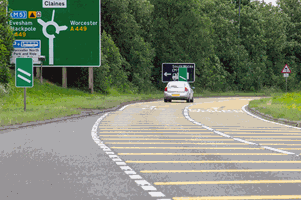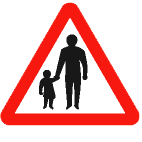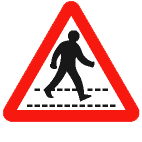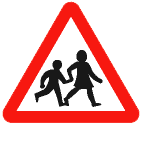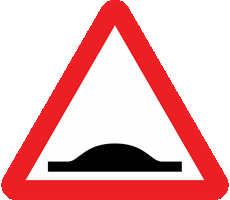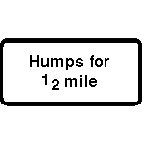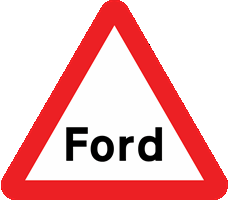You have 57 minutes to answer 50 multiple choice theory test questions. You need to answer at least 43 out of 50 questions correctly to pass. You can review your answer after each question or you can review all of your answers at the end of the test. Best of luck!
Test Quick View
Click on an answer to view the correct choice along with the explanation.
Correct Answer: C
Explanation: The safest option is to switch off your mobile phone before you set off, and use a message service. Even hands-free systems are likely to distract your attention. Don't endanger other road users. If you need to make a call, pull up in a safe place when you can, you may need to go some distance before you can find one. It's illegal to use a hand-held mobile or similar device when driving or riding, except in a genuine emergency
Explanation: The safest option is to switch off your mobile phone before you set off, and use a message service. Even hands-free systems are likely to distract your attention. Don't endanger other road users. If you need to make a call, pull up in a safe place when you can, you may need to go some distance before you can find one. It's illegal to use a hand-held mobile or similar device when driving or riding, except in a genuine emergency
Correct Answer: C
Explanation: These lines are often found on the approach to a roundabout or a dangerous junction. They give you extra warning to adjust your speed. Look well ahead and do this in good time.
Explanation: These lines are often found on the approach to a roundabout or a dangerous junction. They give you extra warning to adjust your speed. Look well ahead and do this in good time.
Correct Answer: A
Explanation: Adjust your speed in good time and select the correct gear for your speed. Going too fast into the bend could cause you to lose control. Braking late and harshly while changing direction reduces your vehicle's grip on the road, and is likely to cause a skid.
Explanation: Adjust your speed in good time and select the correct gear for your speed. Going too fast into the bend could cause you to lose control. Braking late and harshly while changing direction reduces your vehicle's grip on the road, and is likely to cause a skid.
4. You are turning left from a main road into a side road. People are already crossing the road into which you are turning. You should
Mark one answer
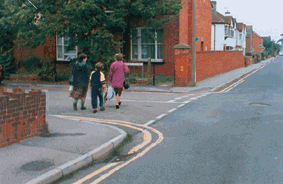
B
C
D
Correct Answer: D
Explanation: Always check the road into which you are turning. Approaching at the correct speed will allow you enough time to observe and react. Give way to any pedestrians already crossing the road.
Explanation: Always check the road into which you are turning. Approaching at the correct speed will allow you enough time to observe and react. Give way to any pedestrians already crossing the road.
Correct Answer: A
Explanation: Toucan crossings are shared by pedestrians and cyclists and they are shown the green light together. Cyclists are permitted to cycle across. The signals are push-button operated and there is no flashing amber phase.
Explanation: Toucan crossings are shared by pedestrians and cyclists and they are shown the green light together. Cyclists are permitted to cycle across. The signals are push-button operated and there is no flashing amber phase.
6. Which sign tells you that pedestrians may be walking in the road as there is no pavement?
Mark one answer
B
C
D
Correct Answer: A
Explanation: Give pedestrians who are walking at the side of the road plenty of room when you pass them. They may turn around when they hear your engine and unintentionally step into the path of your vehicle.
Explanation: Give pedestrians who are walking at the side of the road plenty of room when you pass them. They may turn around when they hear your engine and unintentionally step into the path of your vehicle.
7. You see a pedestrian with a white stick and red band. This means that the person is
Mark one answer
B
C
D
Correct Answer: B
Explanation: If someone is deaf as well as blind, they may be carrying a white stick with a red reflective band. You can't see if a pedestrian is deaf. Don't assume everyone can hear you approaching.
Explanation: If someone is deaf as well as blind, they may be carrying a white stick with a red reflective band. You can't see if a pedestrian is deaf. Don't assume everyone can hear you approaching.
8. Motorcyclists will often look round over their right shoulder just before turning right. This is because
Mark one answer
B
C
D
Correct Answer: C
Explanation: If you see a motorcyclist take a quick glance over their shoulder, this could mean they are about to change direction. Recognising a clue like this helps you to be prepared and take appropriate action, making you safer on the road.
Explanation: If you see a motorcyclist take a quick glance over their shoulder, this could mean they are about to change direction. Recognising a clue like this helps you to be prepared and take appropriate action, making you safer on the road.
Correct Answer: A
Explanation: Road humps are used to slow down the traffic. They are found in places where there are often pedestrians, such as
- in shopping areas,
- near schools,
- in residential areas. Watch out for people close to the kerb or crossing the road.
Explanation: Road humps are used to slow down the traffic. They are found in places where there are often pedestrians, such as
- in shopping areas,
- near schools,
- in residential areas. Watch out for people close to the kerb or crossing the road.
10. You approach a junction. The traffic lights are not working. A police officer gives this signal. You should
Mark one answer

B
C
D
Correct Answer: A
Explanation: If a police officer or traffic warden is directing traffic you must obey them. They will use the arm signals shown in The Highway Code. Learn what these mean and act accordingly.
Explanation: If a police officer or traffic warden is directing traffic you must obey them. They will use the arm signals shown in The Highway Code. Learn what these mean and act accordingly.
Correct Answer: C
Explanation: It is important to know and obey temporary signs on the motorway: they are there for a reason. You may not be able to see the hazard straight away, as the signs give warnings well in advance, due to the speed of traffic on the motorway.
Explanation: It is important to know and obey temporary signs on the motorway: they are there for a reason. You may not be able to see the hazard straight away, as the signs give warnings well in advance, due to the speed of traffic on the motorway.
12. As you approach a pelican crossing the lights change to green. Elderly people are halfway across. You should
Mark one answer
B
C
D
Correct Answer: C
Explanation: Even if the lights turn to green, wait for them to clear the crossing. Allow them to cross the road in their own time, and don't try to hurry them by revving your engine.
Explanation: Even if the lights turn to green, wait for them to clear the crossing. Allow them to cross the road in their own time, and don't try to hurry them by revving your engine.
13. You are on a road that has no traffic signs. There are street lights. What is the speed limit?
Mark one answer
B
C
D
Correct Answer: B
Explanation: If you aren't sure of the speed limit a good indication is the presence of street lights. If there is street lighting the speed limit will be 30 mph unless otherwise indicated.
Explanation: If you aren't sure of the speed limit a good indication is the presence of street lights. If there is street lighting the speed limit will be 30 mph unless otherwise indicated.
Correct Answer: A
Explanation: Don't park within 10 metres (32 feet) of a junction (unless in an authorised parking place). This is to allow drivers emerging from, or turning into, the junction a clear view of the road they are joining. It also allows them to see hazards such as pedestrians or cyclists at the junction.
Explanation: Don't park within 10 metres (32 feet) of a junction (unless in an authorised parking place). This is to allow drivers emerging from, or turning into, the junction a clear view of the road they are joining. It also allows them to see hazards such as pedestrians or cyclists at the junction.
Correct Answer: B
Explanation: These lines may be painted on the road on the approach to a roundabout, village or a particular hazard. The lines are raised and painted yellow and their purpose is to make you aware of your speed. Reduce your speed in good time so that you avoid having to brake harshly over the last few metres before reaching the junction.
Explanation: These lines may be painted on the road on the approach to a roundabout, village or a particular hazard. The lines are raised and painted yellow and their purpose is to make you aware of your speed. Reduce your speed in good time so that you avoid having to brake harshly over the last few metres before reaching the junction.
B
C
D
E
Correct Answer: B, E
Explanation: If you accumulate six or more penalty points within two years of gaining your first full licence it will be revoked. The six or more points include any gained due to offences you committed before passing your test. If this happens you may only drive as a learner until you pass both the theory and practical tests again.
Explanation: If you accumulate six or more penalty points within two years of gaining your first full licence it will be revoked. The six or more points include any gained due to offences you committed before passing your test. If this happens you may only drive as a learner until you pass both the theory and practical tests again.
Correct Answer: C
Explanation: To measure this, choose a fixed reference point such as a bridge, sign or tree. When the vehicle ahead passes the object, say to yourself 'Only a fool breaks the two-second rule.' If you reach the object before you finish saying this, you're TOO CLOSE.
Explanation: To measure this, choose a fixed reference point such as a bridge, sign or tree. When the vehicle ahead passes the object, say to yourself 'Only a fool breaks the two-second rule.' If you reach the object before you finish saying this, you're TOO CLOSE.
Correct Answer: B
Explanation: Top up the battery with distilled water and make sure each cell plate is covered.
Explanation: Top up the battery with distilled water and make sure each cell plate is covered.
B
C
D
Correct Answer: D
Explanation: Where street repairs have closed off pavements, proceed carefully and slowly as pedestrians might have to walk in the road.
Explanation: Where street repairs have closed off pavements, proceed carefully and slowly as pedestrians might have to walk in the road.
Correct Answer: A
Explanation: Try to give way to buses if you can do so safely, especially when they signal to pull away from bus stops. Look out for people who've stepped off the bus or are running to catch it, and may try to cross the road without looking. Don't try to accelerate past before it moves away or flash your lights as other road users may be misled by this signal.
Explanation: Try to give way to buses if you can do so safely, especially when they signal to pull away from bus stops. Look out for people who've stepped off the bus or are running to catch it, and may try to cross the road without looking. Don't try to accelerate past before it moves away or flash your lights as other road users may be misled by this signal.
Correct Answer: D
Explanation: The white light shows that trams must stop, but the green light shows that other vehicles may go if the way is clear. You may not live in an area where there are trams but you should still learn the signs. You never know when you may go to a town with trams.
Explanation: The white light shows that trams must stop, but the green light shows that other vehicles may go if the way is clear. You may not live in an area where there are trams but you should still learn the signs. You never know when you may go to a town with trams.
22. You are in the right-hand lane on a motorway. You see these overhead signs. This means
Mark one answer

B
C
D
Correct Answer: B
Explanation: You MUST obey this sign. There might not be any visible signs of a problem ahead. However, there might be queuing traffic or another hazard which you cannot yet see.
Explanation: You MUST obey this sign. There might not be any visible signs of a problem ahead. However, there might be queuing traffic or another hazard which you cannot yet see.
Correct Answer: A
Explanation: You should normally travel in the left-hand lane unless you are overtaking a slower-moving vehicle. When you are past that vehicle move back into the left-hand lane as soon as it's safe to do so. Don't cut across in front of the vehicle that you're overtaking.
Explanation: You should normally travel in the left-hand lane unless you are overtaking a slower-moving vehicle. When you are past that vehicle move back into the left-hand lane as soon as it's safe to do so. Don't cut across in front of the vehicle that you're overtaking.
Correct Answer: A
Explanation: If you want to keep a vehicle off the public road you must declare SORN. It is an offence not to do so. You then won't have to pay vehicle excise duty (road tax). Your SORN is valid until your vehicle is taxed, sold or scrapped.
Explanation: If you want to keep a vehicle off the public road you must declare SORN. It is an offence not to do so. You then won't have to pay vehicle excise duty (road tax). Your SORN is valid until your vehicle is taxed, sold or scrapped.
25. Planning your journey to avoid busy times has a number of advantages. One of these is
Mark one answer
B
C
D
Correct Answer: B
Explanation: Having a pleasant journey can have safety benefits. You will be less tired and stressed and this will allow you to concentrate more on your driving or riding.
Explanation: Having a pleasant journey can have safety benefits. You will be less tired and stressed and this will allow you to concentrate more on your driving or riding.
Correct Answer: D
Explanation: A ford is a crossing over a stream that's shallow enough to go through. After you've gone through a ford or deep puddle the water will affect your brakes. To dry them out apply a light brake pressure while moving slowly. Don't travel at normal speeds until you are sure your brakes are working properly again.
Explanation: A ford is a crossing over a stream that's shallow enough to go through. After you've gone through a ford or deep puddle the water will affect your brakes. To dry them out apply a light brake pressure while moving slowly. Don't travel at normal speeds until you are sure your brakes are working properly again.
Correct Answer: C
Explanation: You should not normally stop on a motorway but there may be occasions when you need to do so. If you are unfortunate enough to break down make every effort to pull up on the hard shoulder.
Explanation: You should not normally stop on a motorway but there may be occasions when you need to do so. If you are unfortunate enough to break down make every effort to pull up on the hard shoulder.
28. Following a collision someone has suffered a burn. The burn needs to be cooled. What is the shortest time it should be cooled for?
Mark one answer
B
C
D
Correct Answer: C
Explanation: Check the casualty for shock and if possible try to cool the burn for at least 20 minutes. Use a clean, cold non-toxic liquid preferably water.
Explanation: Check the casualty for shock and if possible try to cool the burn for at least 20 minutes. Use a clean, cold non-toxic liquid preferably water.
Correct Answer: A, B, D
Explanation: Slow down and be ready to stop if you see animals in the road ahead. Animals are easily frightened by noise and vehicles passing too close to them. Stop if signalled to do so by the person in charge.
Explanation: Slow down and be ready to stop if you see animals in the road ahead. Animals are easily frightened by noise and vehicles passing too close to them. Stop if signalled to do so by the person in charge.
30. You arrive at the scene of an incident. It has just happened and someone is unconscious. Which THREE of these should be given urgent priority to help them?
Mark three answers
B
C
D
E
F
Correct Answer: A, B, D
Explanation: Make sure that the emergency services are called immediately. Once first aid has been given, stay with the casualty.
Explanation: Make sure that the emergency services are called immediately. Once first aid has been given, stay with the casualty.
31. At an incident a casualty is unconscious but still breathing. You should only move them if
Mark one answer
B
C
D
Correct Answer: D
Explanation: Do not move a casualty unless there is further danger, for example, from other traffic or fire. They may have unseen or internal injuries. Moving them unnecessarily could cause further injury. Do NOT remove a motorcyclists helmet unless it's essential.
Explanation: Do not move a casualty unless there is further danger, for example, from other traffic or fire. They may have unseen or internal injuries. Moving them unnecessarily could cause further injury. Do NOT remove a motorcyclists helmet unless it's essential.
32. At a collision you suspect a casualty has back injuries. The area is safe. You should
Mark one answer
B
C
D
Correct Answer: B
Explanation: Talk to the casualty and keep them calm. Do not attempt to move them as this could cause further injury. Call an ambulance at the first opportunity.
Explanation: Talk to the casualty and keep them calm. Do not attempt to move them as this could cause further injury. Call an ambulance at the first opportunity.
33. You are behind this cyclist. When the traffic lights change, what should you do?
Mark one answer

B
C
D
Correct Answer: A
Explanation: Hold back and allow the cyclist to move off. In some towns, junctions have special areas marked across the front of the traffic lane. These allow cyclists to wait for the lights to change and move off ahead of other traffic.
Explanation: Hold back and allow the cyclist to move off. In some towns, junctions have special areas marked across the front of the traffic lane. These allow cyclists to wait for the lights to change and move off ahead of other traffic.
Correct Answer: A
Explanation: Crosswinds can blow a motorcyclist or cyclist across the lane. Passing too close could also cause a draught, unbalancing the rider.
Explanation: Crosswinds can blow a motorcyclist or cyclist across the lane. Passing too close could also cause a draught, unbalancing the rider.
35. Hills can affect the performance of your vehicle. Which TWO apply when driving up steep hills?
Mark two answers
B
C
D
E
Correct Answer: C, E
Explanation: The engine will need more power to pull the vehicle up the hill. When approaching a steep hill you should select a lower gear to help maintain your speed. You should do this without hesitation, so that you don't lose too much speed before engaging the lower gear.
Explanation: The engine will need more power to pull the vehicle up the hill. When approaching a steep hill you should select a lower gear to help maintain your speed. You should do this without hesitation, so that you don't lose too much speed before engaging the lower gear.
36. You are waiting at a T-junction. A vehicle is coming from the right with the left signal flashing. What should you do?
Mark one answer
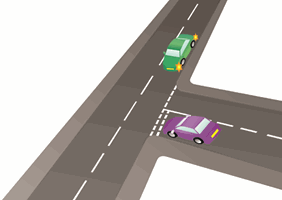
B
C
D
Correct Answer: D
Explanation: Other road users may give misleading signals. When you're waiting at a junction don't emerge until you're sure of their intentions.
Explanation: Other road users may give misleading signals. When you're waiting at a junction don't emerge until you're sure of their intentions.
Correct Answer: C
Explanation: Pull up on the hard shoulder and make your way to the nearest emergency telephone to call for assistance. Do not attempt to repair your vehicle while it is on the hard shoulder because of the risk posed by traffic passing at high speeds.
Explanation: Pull up on the hard shoulder and make your way to the nearest emergency telephone to call for assistance. Do not attempt to repair your vehicle while it is on the hard shoulder because of the risk posed by traffic passing at high speeds.
Correct Answer: B
Explanation: Strong winds or buffeting from large vehicles can cause a trailer or caravan to snake or swerve. If this happens, ease off the accelerator. Don't brake harshly, steer sharply or increase your speed.
Explanation: Strong winds or buffeting from large vehicles can cause a trailer or caravan to snake or swerve. If this happens, ease off the accelerator. Don't brake harshly, steer sharply or increase your speed.
Correct Answer: B, C, E
Explanation: Other things to check include lights, get someone to help you check the brake lights and indicators. Battery, a lot of these are now maintenance-free. Steering, check for play in the steering. Oil, water and suspension also need checking. Always check that the speedometer is working once you've moved off.
Explanation: Other things to check include lights, get someone to help you check the brake lights and indicators. Battery, a lot of these are now maintenance-free. Steering, check for play in the steering. Oil, water and suspension also need checking. Always check that the speedometer is working once you've moved off.
B
C
D
Correct Answer: D
Explanation: You can move into the box junction to wait as long as your exit is clear. The oncoming traffic will stop when the traffic lights change, allowing you to proceed.
Explanation: You can move into the box junction to wait as long as your exit is clear. The oncoming traffic will stop when the traffic lights change, allowing you to proceed.
Correct Answer: A
Explanation: If you have a garage, use it. Your vehicle is less likely to be a victim of car crime if it's in a garage. Also in winter the windows will be free from ice and snow.
Explanation: If you have a garage, use it. Your vehicle is less likely to be a victim of car crime if it's in a garage. Also in winter the windows will be free from ice and snow.
42. You are driving at night with full beam headlights on. A vehicle is overtaking you. You should dip your lights
Mark one answer
B
C
D
Correct Answer: A
Explanation: On full beam your lights could dazzle the driver in front. Make sure that your light beam falls short of the vehicle in front.
Explanation: On full beam your lights could dazzle the driver in front. Make sure that your light beam falls short of the vehicle in front.
B
C
D
Correct Answer: B
Explanation: Windscreen pillars can obstruct your view, particularly at bends and junctions. Look out for other road users, particularly cyclists and pedestrians, as they can be hard to see.
Explanation: Windscreen pillars can obstruct your view, particularly at bends and junctions. Look out for other road users, particularly cyclists and pedestrians, as they can be hard to see.
Correct Answer: A, C, D
Explanation: Think about the effect your parking will have on other road users. Don't forget that not all vehicles are the size of a car. Large vehicles will need more room to pass and might need more time too.Parking out of the view of traffic, such as before the brow of a hill, causes unnecessary risks. Think before you park.
Explanation: Think about the effect your parking will have on other road users. Don't forget that not all vehicles are the size of a car. Large vehicles will need more room to pass and might need more time too.Parking out of the view of traffic, such as before the brow of a hill, causes unnecessary risks. Think before you park.
Correct Answer: B
Explanation: Having your vehicle broken into or stolen can be very distressing and inconvenient. Avoid leaving your vehicle unattended in poorly-lit areas.
Explanation: Having your vehicle broken into or stolen can be very distressing and inconvenient. Avoid leaving your vehicle unattended in poorly-lit areas.
46. You are parked in a busy high street. What is the safest way to turn your vehicle around so you can go the opposite way?
Mark one answer
B
C
D
Correct Answer: C
Explanation: Make sure you carry out the manoeuvre without causing a hazard to other vehicles. Choose a place to turn which is safe and convenient for you and for other road users.
Explanation: Make sure you carry out the manoeuvre without causing a hazard to other vehicles. Choose a place to turn which is safe and convenient for you and for other road users.
Correct Answer: D
Explanation: Missing out some gears helps to reduce the amount of time you are accelerating and this saves fuel. You don't always need to change up or down through each gear. As you accelerate between each gear more fuel is injected into the engine than if you had maintained constant acceleration. Fewer gear changes means less fuel used.
Explanation: Missing out some gears helps to reduce the amount of time you are accelerating and this saves fuel. You don't always need to change up or down through each gear. As you accelerate between each gear more fuel is injected into the engine than if you had maintained constant acceleration. Fewer gear changes means less fuel used.
Correct Answer: A
Explanation: Always try to use the accelerator smoothly. Taking your foot off the accelerator allows the momentum of the car to take you forward, especially when going downhill. This can save a considerable amount of fuel without any loss of control over the vehicle.
Explanation: Always try to use the accelerator smoothly. Taking your foot off the accelerator allows the momentum of the car to take you forward, especially when going downhill. This can save a considerable amount of fuel without any loss of control over the vehicle.
Correct Answer: A
Explanation: When adult passengers are travelling in a vehicle, it is their own responsibility to wear a seat belt. However, you should still remind them to use a seat belt.
Explanation: When adult passengers are travelling in a vehicle, it is their own responsibility to wear a seat belt. However, you should still remind them to use a seat belt.
Correct Answer: A, D
Explanation: You should not use rear fog lights unless visibility is seriously reduced. A warning light will show on the dashboard to indicate when your rear fog lights are on. You should know the meaning of all the lights on your dashboard and check them before you move off and as you drive.
Explanation: You should not use rear fog lights unless visibility is seriously reduced. A warning light will show on the dashboard to indicate when your rear fog lights are on. You should know the meaning of all the lights on your dashboard and check them before you move off and as you drive.



